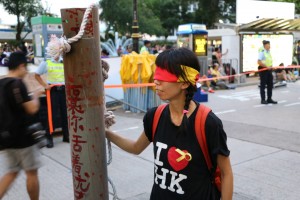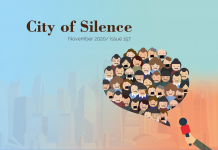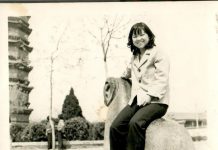Chen recalls the seemingly crazy performance art he did at the controversial Yasukuni Shrine in Japan, where the victims of war are commemorated alongside convicted war criminals.
In response to then-Japanese Prime Minister Junichiro Koizumi’s visit to the shrine on August 13 2001, Chen stood on a newspaper printed with Koizumi’s speech at the entrance of the shrine. Then he wrapped his head with newspaper, sprayed his face red, and pointed his finger at the shrine. “I made my intention clear,” Chen says. His performance took place just two days after Koizumi’s visit.
Chen was beaten up by right-wing extremists for his show, and has a scar on his forehead to show for it. But he does not regret his action.
“I don’t agree with putting victims and victimisers in the same shrine for people to worship. This is an insult to victims,” he says, “Have you ever heard of putting Jews and Nazis right next to each other?”
Chen’s performance art is not just about a purist pursuit of art. It is a way for him to express his thoughts on current issues. And he is not the only artist who feels that way about his art.
The artist Wenyau also sees performance art as a way to express her politics. She began to explore performance art when she was studying for a master’s degree in cultural and media studies in the United Kingdom and started her performance art career in 2003.
After a decade, Wenyau is now best known for her experimental performance art. She believes performance art is like “breaking the wall” – challenging the status quo.

She thinks her most remarkable piece is the enactment of Homage to Seiji Shimoda: On the Table. Shimoda is a well-received performance artist in Japan who created the piece On the Table. In the piece, Shimoda moves his naked body around a wooden table without touching the ground. As Wenyau puts it, “one can see the concentrated physical energy in a breathtaking feat of stamina”.
Wenyau performed On the Table after seeking permission from Shimoda to do so at an art festival. “I just kept falling onto the ground, then trying to crawl onto the table again,” she recalls of her performance.
It moved the audience – a Japanese girl hugged her tightly after the show, and had tears coming out of her eyes when she told Wenyau how much she had enjoyed the performance.
“Seiji’s performance is about success, mine is about failure,” said Wenyau, “I put forward a question – why does a man have to master a table.”
Some critics question if performance artists, like Wenyau and Sammu Chen are too political. But for Wenyau, everything is politics. She quotes the French writer Jean Genet who said that if you do not want to be political, do not write essays or speak out.
“To me, On the Table is about gender-politics or body politics”, she adds. “Just sometimes, we perceive politics in a much narrower sense.”
Politics seems to inspire many performance artists. According to a report published by the Asian Art Archive, performance art with socio-political elements began to emerge after 1989 and has been developing ever since. It is more apparent in politically volatile years, like 1997 and 2003.










































